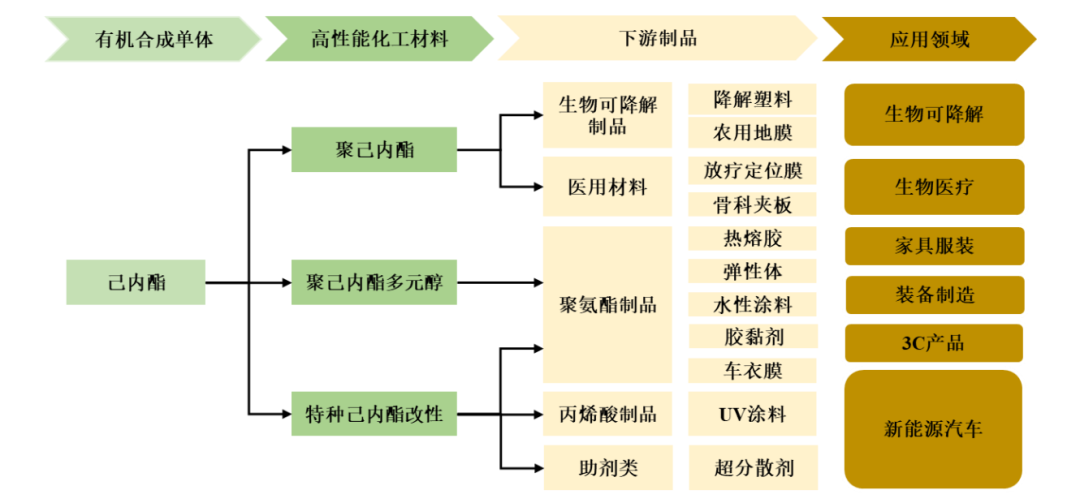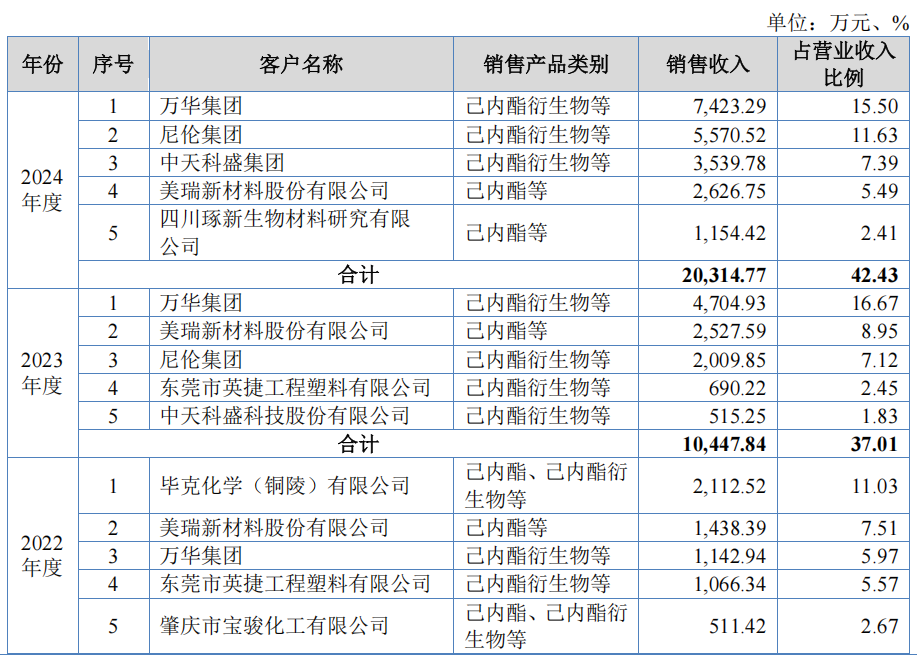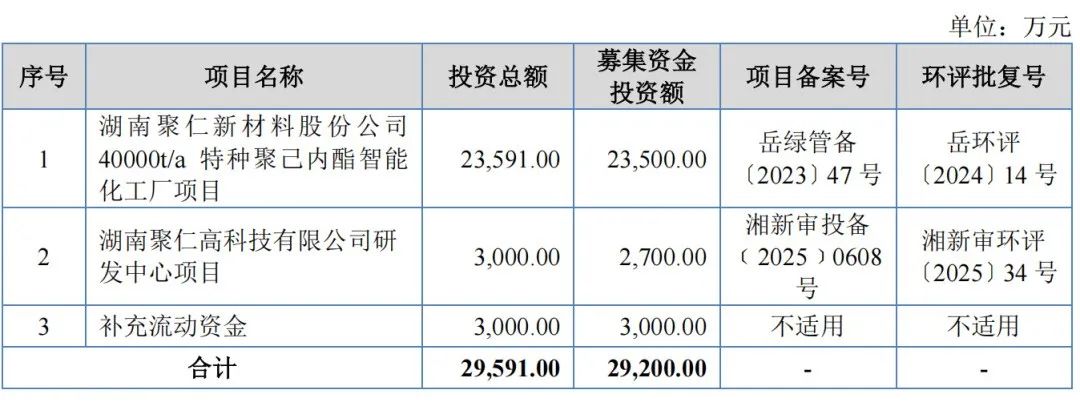Largest in China! Supplier to Wanhua Chemical and Meirui New Material Pursues IPO
Recently, Hunan Juren New Materials Co., Ltd. (Juren New Materials) received acceptance for its IPO on the Beijing Stock Exchange.
Juren New Materials was established in 2014, headquartered in the Green Chemical Industry Park of Yueyang, Hunan Province, focusing on the research and production of ε-caprolactone (ε-CL) and its derivatives. The company's core technological breakthrough began in 2016—under foreign technology embargoes, it independently built the country's first domestic thousand-ton-scale industrial ε-caprolactone production facility, breaking the monopoly held by Europe and the United States. Since then, the company has continuously upgraded its technology. In 2021, it achieved mass production of polycaprolactone (PCL) biodegradable materials, and in 2023, it put into operation the world's largest single 50,000-ton-per-year green biodegradable material production line. The product performance is comparable to international giants BASF and Eastman.

As of 2025, the company owns 34 patents (including 28 invention patents), has established a full-chain technology transformation system from basic research to pilot incubation to industrialization, and has obtained international certifications such as EU REACH and Korea K-REACH. It has entered the international supply chain systems of BASF, BYK, Lubrizol, and Covestro. Its independently developed large-scale continuous production line reduces production costs by more than 20%. The company has been recognized as a national-level "Little Giant" specialized and innovative enterprise and a national high-tech enterprise.
In addition, its research and development team has jointly established a national-local joint laboratory for environmentally friendly polymer materials with Sichuan University, focusing on the pilot production base for caprolactone and its derivatives. It has also collaborated with higher education institutions such as Wuhan University of Technology, Hunan Normal University, and Xiangtan University to build an industry-university-research cooperation ecosystem.

Market share remains firmly ranked first domestically
Juren New Materials’ products cover two major categories: caprolactone and its derivatives. The company has established three major derivative systems: polycaprolactone, polycaprolactone polyols (PCL polyols), and specialty caprolactone-modified materials. Four specialized product lines have been developed: dispersants (M series), elastomers (T series), foaming materials (P series), and coating substrates (H series). These products can be applied in fields such as polyurethane products, acrylic products, biodegradable products, medical materials, and additives.


Especially in the field of medical materials, polycaprolactone, due to its low melting point plasticity, shape memory function, and biocompatibility, can be used in medical devices and auxiliary materials such as tumor radiotherapy positioning membranes, coronary stents, orthopedic implant consumables, drug delivery carriers, soft tissue sutures for bone connection, and facial fillers. China's 14th Five-Year Plan proposes to focus on the development of fully degradable vascular stents and other high-value medical devices, and the application of biodegradable plastics in the medical field is expected to further expand in the future.
According to data from the China Petroleum and Chemical Industry Federation, Juren New Material's domestic market share increased from 35.19% in 2022 to 37.21% in 2023, firmly maintaining its position as the largest supplier of caprolactone series products in China.
Explosive growth in performance over the past three years
The prospectus shows that Juren New Materials has experienced explosive growth in performance over the past three years.
This growth is attributed to the surge in demand from downstream sectors such as new energy vehicles and biodegradable materials. For instance, its polycaprolactone polyol (PCL polyol) is used in lightweight components for new energy vehicles, with related revenue expected to increase by 120% year-on-year in 2024. Meanwhile, polycaprolactone (PCL), driven by the "plastic ban," has seen its sales double in the biodegradable packaging sector.
In the first quarter of 2025, the company achieved an operating income of 153 million yuan, a year-on-year increase of 58.58%; the net profit attributable to the parent company was 29.7845 million yuan, a year-on-year increase of 45.29%, mainly due to the growth in sales volume of the company's main products, caprolactone and caprolactone derivatives.
The main business operations of Juren New Materials are as follows:

Global Deployment
==== New Material has established deep cooperation with industry leading companies such as Wanhua Chemical, Meirui New Material, Nilon Chemical, and Zhongtian Kesheng. Additionally, it is actively expanding collaborative synergies with domestic industry giants like BYD and Hisun Biomaterials in the upstream and downstream of the supply chain. The sales to the top five customers accounted for 42.43% before 2024.
Top five customers from 2022 to 2024:


The funds raised from this IPO will be primarily invested in two areas: first, 235 million RMB will be invested in constructing a 40,000-ton smart factory for specialty polycaprolactone, focusing on high-end medical-grade and electronic-grade products, with an expected annual revenue increase of 2 billion RMB upon reaching full production capacity; second, 27 million RMB will be invested in upgrading the R&D center to tackle bio-based caprolactone and CO₂-based degradable materials, in response to the "dual carbon" policy. Additionally, 30 million RMB will be used to supplement working capital, optimize cash flow, ensure raw material procurement, and expand market development.

What is the market situation of caprolactone?
In terms of production capacity, the global total capacity of caprolactone is approximately 115,000 tons per year. Major enterprises with large-scale production include Jurong New Material (50,000 tons/year), Invista (40,000 tons/year) in the United States, Daicel (20,000 tons/year) in Japan, and BASF (5,000 tons/year) in Germany.

From the demand side, the domestic caprolactone market size is approximately 1.5 billion yuan, with an annual growth rate of over 10%, primarily driven by new energy vehicles and biodegradable materials.
Despite significant advantages, multiple challenges still need to be addressed: concerns about raw material fluctuations and overcapacity.
The prices of cyclohexanone and hydrogen peroxide are greatly influenced by the oil market, resulting in a 14.77 percentage point decrease in gross profit margin in 2024.
Some domestic companies are actively advancing the layout of the caprolactone-related industry: Hubei Wangjiang New Materials has received environmental assessment approval for its project to produce 50,000 tons of caprolactone monomer, 50,000 tons of polycaprolactone polyol, and 10,000 tons of polycaprolactone annually; Sinopec Hunan Petrochemical has released the first public information regarding the environmental impact assessment of its 10,000-ton/year caprolactone industrial demonstration unit; Anhui Tiger Vitamin Industrial Co., Ltd. has issued the first public notice for environmental impact assessment for its 100,000-ton/year caprolactone project (Phase I, 15,000 tons/year); Weibojie Biomaterials (Zhejiang) Co., Ltd. has announced the environmental impact assessment for its production base project with an annual output of 30,000 tons of caprolactone and polycaprolactone.
【Copyright and Disclaimer】The above information is collected and organized by PlastMatch. The copyright belongs to the original author. This article is reprinted for the purpose of providing more information, and it does not imply that PlastMatch endorses the views expressed in the article or guarantees its accuracy. If there are any errors in the source attribution or if your legitimate rights have been infringed, please contact us, and we will promptly correct or remove the content. If other media, websites, or individuals use the aforementioned content, they must clearly indicate the original source and origin of the work and assume legal responsibility on their own.
Most Popular
-

List Released! Mexico Announces 50% Tariff On 1,371 China Product Categories
-

Nissan Cuts Production of New Leaf EV in Half Due to Battery Shortage
-

New Breakthrough in Domestic Adiponitrile! Observing the Rise of China's Nylon Industry Chain from Tianchen Qixiang's Production
-

Dow, Wanhua, Huntsman Intensively Raise Prices! Who Controls the Global MDI Prices?
-

Mexico officially imposes tariffs on 1,400 chinese products, with rates up to 50%






